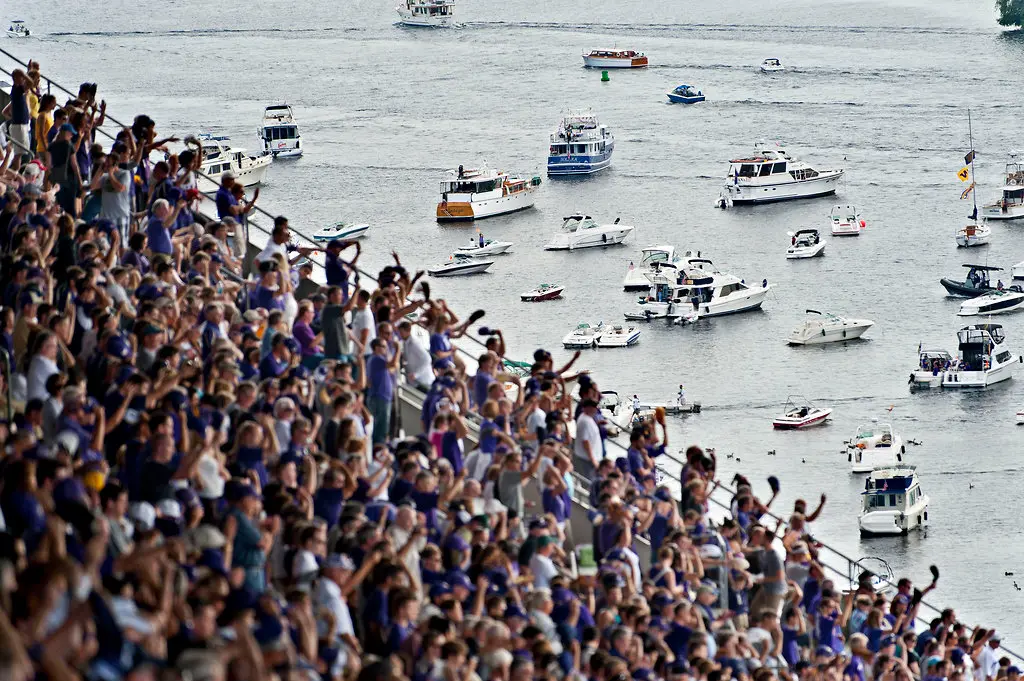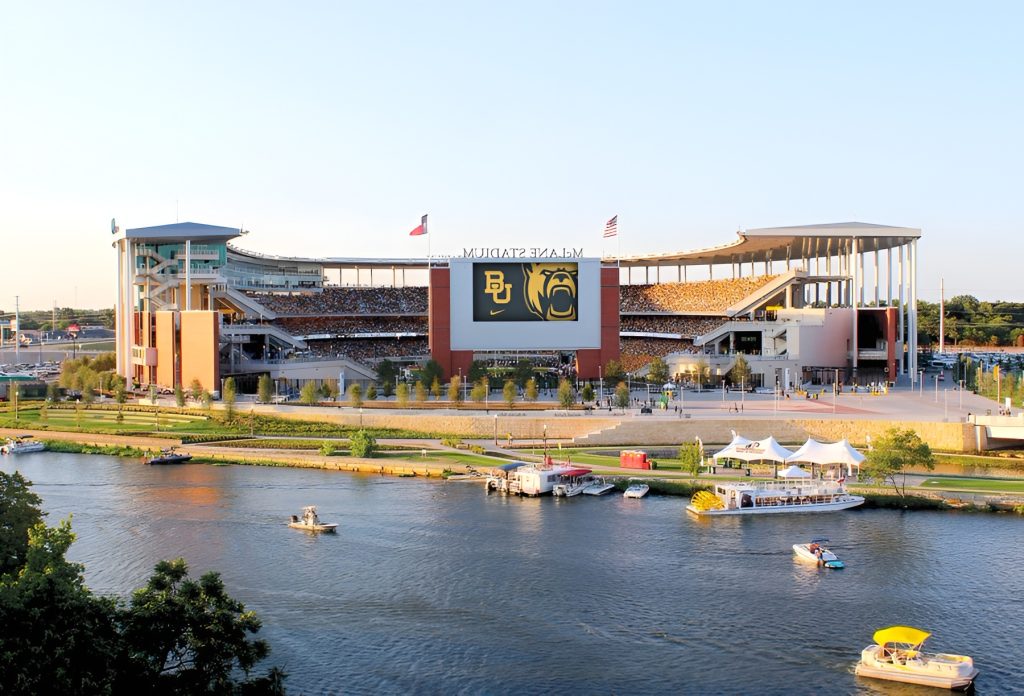On autumn Saturdays across America, tailgaters fire up grills in parking lots, unfold lawn chairs, and claim their asphalt kingdoms hours before kickoff. But at a few storied college football venues, fans arrive by an entirely different route—one that requires navigation lights, dock lines, and a healthy respect for the wind.
Tennessee’s Vol Navy and Washington’s Husky Stadium sailgating represent something rare in American sports: traditions where the journey to the game rivals the spectacle inside the stadium. These aren’t just parking lot parties relocated to pontoons. They’re living expressions of how place and passion converge, how geography shapes ritual, and how a simple idea—watching football from a boat—can become woven into the identity of an entire fanbase.
The Vol Navy: Orange on the Tennessee
The Tennessee River flows past Neyland Stadium like a liquid highway, its current steady and indifferent to the 100,000 fans who gather on its banks each fall. But on game days, that indifference vanishes. The river transforms into something approaching organized chaos—a maritime parking lot where vessels of every description jostle for position, their orange flags snapping in the breeze.

It started, as many great traditions do, with one person solving a problem. In 1962, a local sportscaster named George Mooney grew tired of game-day traffic snarls. He owned a ski boat. Neyland Stadium sat on the river. The math was simple. Mooney motored up to the game, tied off, and walked into the stadium. Others noticed. They had boats too.
What began as traffic avoidance evolved into something much larger. By the time the tradition earned its formal name—the Vol Navy—it had become the largest college sailgating fleet in America. On big game days, an estimated 350 boats now converge on the water across from Neyland Stadium, creating a floating city that arrives with the dawn and doesn’t disperse until well after the final whistle.
The scale defies easy description. Boats range from modest fishing skiffs to luxurious yachts, from pontoons strung with speaker systems to houseboats that serve as floating command centers for extended tailgating operations. Some fans dock for a single Saturday. Others secure seasonal slips, treating their vessels as weekend condos with a view of one of college football’s most iconic venues. The atmosphere pulses with that particular energy that comes from thousands of people united by team colors and watercraft—grills sizzling, music competing across the water, the smell of barbecue mixing with diesel fumes and river air.
The stadium itself looms just across the water, close enough that Vol Navy members can hear the roar of the crowd during big plays. Some fans watch entire games from their boats, turning decks into floating skyboxes. Others make the 15-minute walk to the stadium, leaving their vessels as launching pads for post-game celebrations that stretch long into the Tennessee night.
Husky Stadium: Built With Lake Views And Sky
If Tennessee’s tradition emerged from creative problem-solving, Washington’s was practically inevitable. When Husky Stadium opened in 1920, it didn’t just sit near water—it was built directly on the shore of Lake Washington, its southern edge mere hundreds of feet from the lake’s shimmering surface. The stadium’s location was a dare, an invitation, an architectural statement that seemed to ask: Why would you drive here when you could sail?


Fans accepted that invitation almost immediately. In those early years, supporters would pilot their boats across the lake, beach them on the shore, and walk straight into the stadium. The practice grew organically, shaped by Seattle’s deep maritime culture and the practical reality that approaching the stadium by water often proved easier than navigating Seattle’s streets.
A century later, that tradition hasn’t just survived—it’s flourished into one of college football’s most distinctive pre-game spectacles. Thousands of fans now participate in what’s simply known as Husky Stadium sailgating, arriving in vessels that range from small personal watercraft to substantial charter boats that ferry groups of purple-clad faithful across the lake.
The atmosphere differs from Tennessee’s concentrated armada. Washington’s sailgating spreads across a wider canvas, with some boats docking close to shore near the stadium while others anchor further out on the lake, creating layers of celebration that ripple across the water. The university enhances the experience with a water taxi service—a free shuttle that ferries fans from their anchored boats to the shore, a small but meaningful gesture that acknowledges sailgating as integral to the Husky experience rather than a quirky sideshow.
On crisp Pacific Northwest fall days, the view from the stadium is spectacular: Lake Washington glittering under autumn sun, the Cascade Mountains rising in the distance, and hundreds of boats dotting the water like a regatta designed by football fans. It’s a scene that could only exist in Seattle, where the culture of boating runs as deep as the love of football.
Two Rivers, One Tradition
These traditions share DNA but wear different faces. Tennessee’s Vol Navy presents as a concentrated armada, a massive flotilla that creates its own ecosystem across from the stadium. Washington’s sailgating feels more dispersed, woven into the broader fabric of Seattle’s water culture and the stadium’s unique geography.
Yet both speak to something fundamental about why sports matter—not just for the games themselves, but for the communities they create and the traditions they inspire. In an era when much of sports culture has been sanitized, corporatized, and stripped of local flavor, sailgating remains defiantly authentic. It can’t be replicated in a parking garage or manufactured by a marketing department. It exists because rivers flow past stadiums, because lakes sparkle in autumn sun, because fans looked at water and saw possibility.
On fall Saturdays in Knoxville and Seattle, that possibility becomes reality. Boats gather. Grills fire up. Music drifts across the water. And somewhere in the distance, 100,000 voices rise in unison, carried on the wind to those who chose to arrive by an older, slower, infinitely more memorable path—one that requires no traffic report, only tide charts and the knowledge that the best journeys are rarely the fastest ones.

Other Colleges Where You Can Arrive by Boat
While Tennessee and Washington remain the crown jewels of college sailgating, they’re not alone in offering water access to football games. A small but growing fraternity of schools has embraced the marriage of boats and touchdowns:
Baylor University (Waco, Texas) – McLane Stadium sits on the Brazos River with a lagoon and boat basin just steps from the stadium. When the stadium opened in 2014, Baylor joined Tennessee and Washington in offering sailgating immediately adjacent to the stadium. The “Bearmada” gathers in the Baylor Basin, with seasonal boat slips available and first-come, first-served tie-up spots along the retaining wall.
University of Pittsburgh (Pittsburgh, Pennsylvania) – Acrisure Stadium (formerly Heinz Field) sits at the confluence of the Allegheny and Ohio Rivers. Boaters can line the North Shore wall outside the stadium or dock at Washington’s Landing Marina about two miles up the Allegheny, which offers shuttles to games. The stadium serves both the NFL’s Steelers and college’s Pitt Panthers.

These programs prove that while the scale and history may differ, the fundamental appeal remains universal: why sit in traffic when you can sail to the game?

